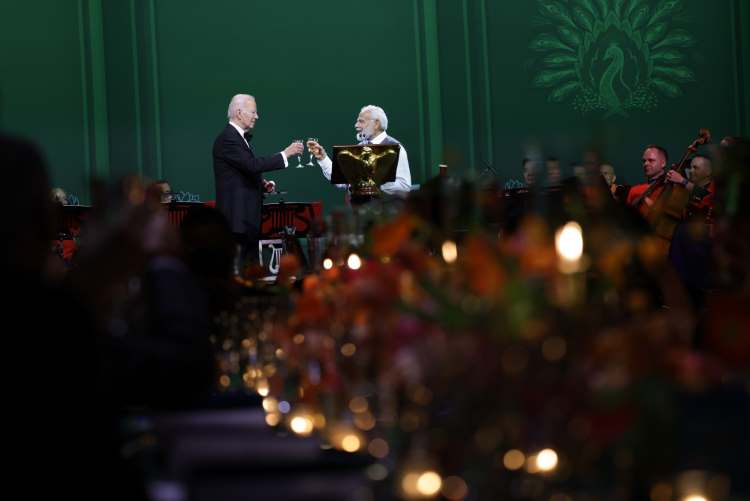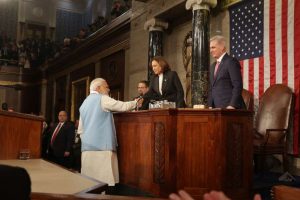
India-US relations on fast track: Last week, Washington witnessed an extraordinary celebration of the partnership between the world’s two largest democracies. The three-day state visit of Prime Minister Narendra Modi included a series of ceremonial and substantial events — a welcome ceremony on the South Lawn of the White House, a state dinner attended by guests from both nations, a lunch hosted by Vice President Kamala Harris, and two community receptions with more than 2,000 participants.
The delegations agreed to take the bilateral partnership to the next level on a number of issues ranging from artificial intelligence and climate change to space and the Ukraine war.

President Biden and Prime Minister Modi “affirmed a vision of the United States and India as among the closest partners in the world – a partnership of democracies looking into the 21st century with hope, ambition, and confidence,” their joint statement read. It went on to state, “The U.S.-India Comprehensive Global and Strategic Partnership is anchored in a new level of trust and mutual understanding and enriched by the warm bonds of family and friendship that inextricably link our countries together.”
For those who came of age in the 2000s, Biden’s rollout of the red carpet for Modi may have felt quite normal, given the positive trajectory of the India-US relations over the past fifteen years. Throughout this time, the ties have steadily strengthened, overcoming differences and garnering support from Republican and Democratic Presidents alike.
READ I India’s startups ecosystem slows amid funding, policy challenges
A milestone in India-US relations
For someone like me who has lived through the Cold War, a time when the United States and India held different visions of the world, the Prime Ministerial visit held a profound significance, evoking several goose-bump-inducing moments. Among these moments, none was more pronounced than the White House dinner — an event I had the privilege of attending.
The visit was an opportunity to reflect on the transformation of the relationship from one characterised by indifference to one that has the potential to shape the course of a century.
While the news media and commentariat in both nations dissected all aspects of the bilateral ties, regrettably, only a few took a step back to contemplate the journey that brought us to this point and acknowledge the individuals who played a pivotal role in making it happen. The events of last week were made possible by the occurrence of two significant milestones in the 2000s. The first was President Bill Clinton’s to New Delhi visit in March 2000.
India-US relations had reached their lowest point (since the India-Pakistan war of 1971) when Prime Minister Atal Bihari Vajpayee ordered detonation of three nuclear devices in the deserts of Rajasthan. These tests drew condemnation worldwide, with Washington being particularly critical.
President Clinton himself expressed his unequivocal disapproval of the tests. “India’s action threatens the stability of Asia and challenges the firm international consensus to stop all nuclear testing,” he said in the aftermath of the tests. He urged India to “halt its nuclear weapons program and join the 149 other nations that have already signed the comprehensive test ban treaty,” before imposing a series of restrictive sanctions on New Delhi, which included cutting off aid, prohibiting U.S. banks from lending money and limiting exports of computers and other equipment that could also be used by Indian military.
President Clinton’s visit was the first by a US president in more than two decades. It helped normalise the relationship and provided it with a new impetus. It eliminated much of the negativity that had surrounded the bilateral ties and allowed for open dialogue and an opportunity to rebuild trust between the two nations. While the Clinton visit may not have had the same geopolitical significance as President Nixon’s China visit of 1972 which was a turning point in Sino-US relations, there is no doubt that it was a seminal moment.
The second milestone that dramatically changed the relations was the civil nuclear deal signed by the two nations in October 2008. This agreement lifted India’s status within the global nuclear community and resolved a long-standing irritant that had strained bilateral relations for over three decades. In addition to facilitating greater cooperation in the field of civil nuclear energy, it opened avenues for collaboration in various other sectors.
President George W. Bush and Prime Minister Manmohan Singh must be credited for shepherding their respective governments through an arduous negotiation process. Throughout this journey, both leaders faced significant domestic and international opposition. For Singh, it was not just the opposition Bharatiya Janata Party, but the partners of his United Democratic Front were against it.
The civil nuclear deal was a pivotal event in India-US relations. Its symbolic significance lies in the recognition of India as a responsible nuclear power and the removal of a significant hurdle that hindered broader cooperation between the two nations.
Without the nuclear deal, it is difficult to imagine the progress and trajectory of the bilateral ties that ultimately led to last week’s state visit. Therefore, as we celebrate the relations, it is important to remember the pivotal role played by these past milestones. It is upon their foundation that the strong and enduring relationship between the two nations is being built.
Frank F. Islam is an entrepreneur, civic leader, and thought leader based in Washington DC.

